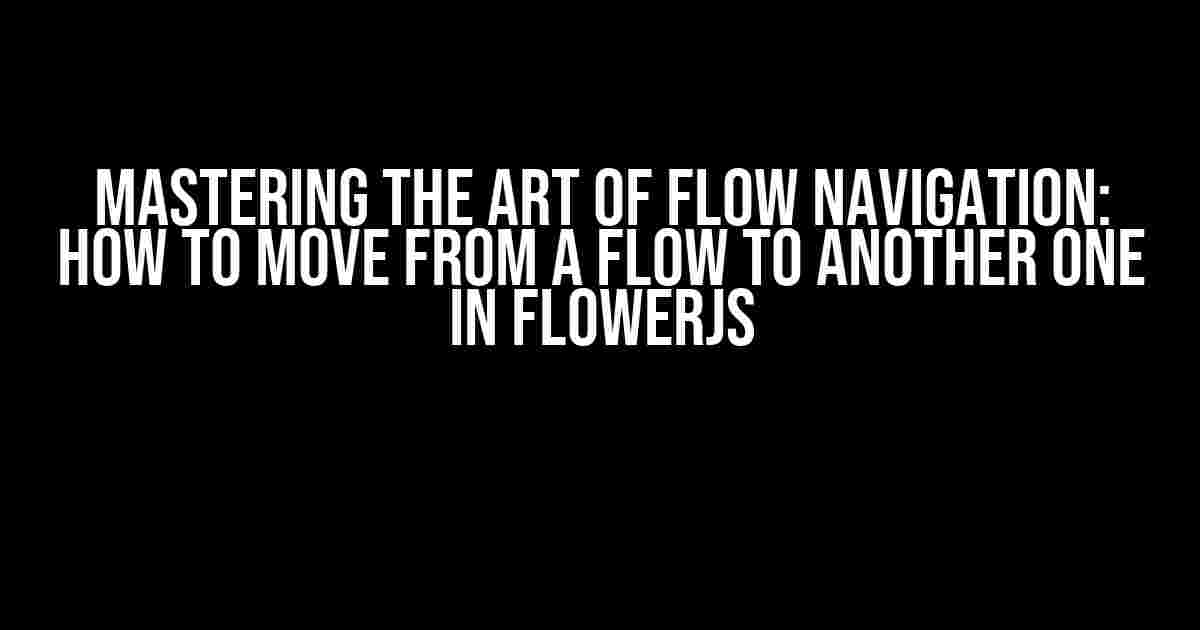Are you tired of being stuck in a single flow, wishing you could effortlessly transition to another one in your Flowerjs application? Look no further! In this comprehensive guide, we’ll walk you through the steps to move from a flow to another one in Flowerjs, ensuring a seamless user experience. Buckle up, and let’s dive in!
Understanding Flows in Flowerjs
Before we dive into the nitty-gritty of flow navigation, it’s essential to understand the concept of flows in Flowerjs. A flow represents a series of steps or interactions that a user undergoes to achieve a specific goal. Think of it as a roadmap that guides your users through your application, providing a structured experience.
In Flowerjs, flows are created using a visual interface, allowing you to design and build complex workflows with ease. However, what happens when you need to move from one flow to another? That’s where the magic happens!
Why Move from One Flow to Another?
There are numerous reasons why you might want to move from one flow to another in Flowerjs. Here are a few scenarios:
-
Conditional logic: You might need to redirect the user to a different flow based on their inputs or actions. For instance, if a user selects a specific option, you want to take them to a distinct flow that caters to their requirements.
-
Multi-step processes: Imagine a scenario where you need to guide the user through a series of complex steps, each requiring a different flow. By moving from one flow to another, you can create a cohesive experience that’s both intuitive and engaging.
-
Error handling: What if the user encounters an error or an exception during a flow? You can redirect them to a dedicated flow that handles errors, providing a soothing experience even in the face of adversity.
How to Move from a Flow to Another One in Flowerjs
Now that we’ve covered the why, let’s get to the how! Moving from one flow to another in Flowerjs involves a few straightforward steps:
Step 1: Create a New Flow
Start by creating a new flow in Flowerjs. This will serve as the destination flow that you want to redirect the user to. Give your flow a descriptive name and add the necessary steps, actions, or conditions as required.
// Create a new flow called "error-handling"
const errorHandlingFlow = await flower.createFlow({
name: "Error Handling",
description: "A flow to handle errors and exceptions",
steps: [
{
type: "error-handler",
handler: (error) => {
console.error(error);
},
},
],
});
Step 2: Add a Redirect Action
In your original flow, add a redirect action that will take the user to the new flow. You can do this by inserting an action node with the type “redirect” and specifying the ID of the destination flow.
// Add a redirect action to the original flow
const originalFlow = await flower.getFlow("original-flow");
const redirectAction = {
type: "redirect",
flowId: errorHandlingFlow.id,
};
originalFlow.steps.push(redirectAction);
Step 3: Configure the Redirect Condition
Define the condition under which the redirect action should be triggered. This could be based on user input, an error occurrence, or any other logic that suits your application’s requirements.
// Configure the redirect condition
const redirectCondition = {
type: "condition",
expression: "error !== null", // Redirect if an error occurs
};
originalFlow.conditions.push(redirectCondition);
Step 4: Save and Test the Changes
Save your changes to the original flow and test the redirect functionality. Trigger the condition that should redirect the user to the new flow, and verify that the transition occurs seamlessly.
| Flow | Condition | Redirect To |
|---|---|---|
| Original Flow | Error occurs | Error Handling Flow |
Best Practices for Flow Navigation
While moving from one flow to another is a powerful feature, it’s essential to follow some best practices to ensure a smooth user experience:
-
Use descriptive flow names and IDs to avoid confusion.
-
Keep your flows organized by categorizing them into folders or labels.
-
Use conditional logic to determine when to redirect the user to another flow.
-
Test your flows thoroughly to ensure that the redirect functionality works as expected.
-
Consider using a central hub flow that acts as a navigation center for your application.
Conclusion
In this comprehensive guide, we’ve covered the steps to move from a flow to another one in Flowerjs. By following these instructions and adhering to best practices, you’ll be able to create a seamless user experience that flows effortlessly from one stage to another. Remember, flow navigation is an art that requires careful planning and execution. With practice and patience, you’ll master the art of moving from one flow to another, elevating your Flowerjs application to new heights!
Happy flowing!
Frequently Asked Question
Get ready to bloom with Flowerjs! If you’re wondering how to move from one flow to another, you’re in the right place. Let’s dive into the FAQs!
How do I move to a new flow from an existing one in Flowerjs?
Ah-ha! To move to a new flow, you can use the `flow.navigate()` method and pass the id of the desired flow as an argument. For example, `flow.navigate(‘new-flow-id’)`. This will seamlessly transition your users to the new flow.
Can I pass data from one flow to another in Flowerjs?
You bet! When moving to a new flow, you can pass data using the `data` option in the `flow.navigate()` method. For instance, `flow.navigate(‘new-flow-id’, { foo: ‘bar’ })`. This will make the data available in the new flow.
What if I want to move to a new flow conditionally in Flowerjs?
Easy peasy! You can use the `flow.navigate()` method within a conditional statement. For example, `if (someCondition) { flow.navigate(‘new-flow-id’) }`. This will only move to the new flow if the condition is met.
How do I handle errors when moving to a new flow in Flowerjs?
Don’t worry, we’ve got you covered! You can catch errors using the `catch` block in the `flow.navigate()` method. For instance, `flow.navigate(‘new-flow-id’).catch((error) => { console.error(error) })`. This will log any errors that occur during the transition.
Can I move to a new flow programmatically in Flowerjs?
Absolutely! You can use the `flow.navigateTo()` method to move to a new flow programmatically. For example, `flow.navigateTo(‘new-flow-id’, { trigger: ‘programmatic’ })`. This will transition to the new flow without user interaction.






